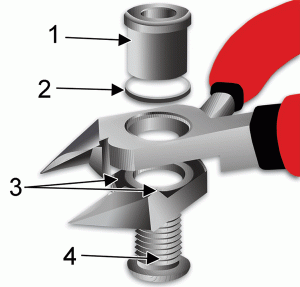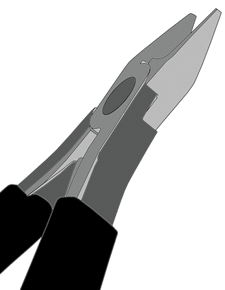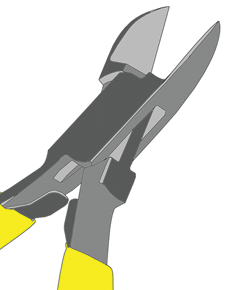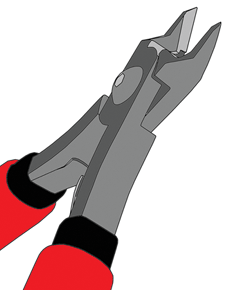Wire Cutter Precision Joint Design

High Precision Adjustable Bolt Joint
Featuring a high precision construction of the wire cutters/pliers join including four important design elements:
- HARDENED NUT is very strong and hardened to endure high cutting loads. Precision machining of the nut insures perfect alignment of the two cutting edges.
- DELRIN WASHER eliminates metal-to-metal wear and reduces friction during operation.
- MATCHED BEARING RINGS minimize metal-to-metal contact and relative joint movement (play).
- ALLEN HEAD SCREW with fine-pitched threads allows for perfect joint adjustment during resharpening.
Superior Wire Cutter Precision Joint Design Guarantees Highest Quality:
- Long Term Cutting Performance before Dulling
- Precise Tip Cutting along the Entire Length of the Cutting Edge
- Cut Wire and Leads as Small as .003mm in Diameter
- Cut Extremely Flush with no Burr or “Pinch”
- Stainless Steel Leaf Springs
- Made in the U.S.A.
| GOOD | BETTER | BEST |
| Standard Lap Joint | Standard Box Joint | Precision Joint Design |
 |
 |
 |
Wire Cutters – High Precision Cutting Edge Types
All high quality wire cutters are compression cutters. This means that both cutting edges cut on the same plane. The cutting motion stops when the two edges hit each other.
Wire cutters such as TDI’s High Precision line are machined as matched pairs of cutting edges. Nevertheless there is generally some edge rounding, some edge overlapping, or some other edge imperfection that prevents the two edges from coming together as two razor blades. The result is that cutting performance may be erratic and very fine leads (05mm and smaller) may not be cut at all.
Manufacturers of very low grade, rivet joint wire cutters stop there. However, all manufacturers of high precision wire cutters provide a final edge finish to yield top cutting performance. Edge finish is best examined by looking at the back, or printed circuit board side, of a wire cutter. Three edge finishes are available:
CUTTING EDGES – SEMI FLUSH
Both cutting edges receive a very small bevel by diamond honing over the whole outer length. The bevels are at 90 degrees to the plane of the cutting surface. The bevels are no more than 0.25 to 0.35mm in width. When the cutter is closed the bevels form a v-shaped groove along the length of the cutting edges.
This beveling results in a fine, but very rugged interface between the the two edges.
In many applications a semi flush cutter can produce hundreds of thousands of cuts before resharpening is necessary. However, the lead or wire being cut will have a raised surface, or “pinch”, exactly in the shape of the v-shaped groove.
CUTTING EDGES – FLUSH
Both cutting edges receive a tiny bevel by diamond honing over the entire outer length. The bevels are at 60 degrees to the plane of the cutting surface. They are no more than 0.12mm in width and thus form an exceptionally small v-shaped groove along the cutting edges.
The beveling also results in a rugged and very long-lasting cutting edge interface for your wire cutters.
It also yields only the tiniest raised surface, or “pinch”, on the cut lead. Many users believe that the flush cutting edge provides the most desirable balance between long cutting life, flush cut leads and cost. This is the most popular choice for most wire cutters applications.
CUTTING EDGES FULL FLUSH
There is no bevel on either cutting edge. The backside, or printed circuit board side, is absolutely flat at an angle of 45 degrees to the plane of the cutting surface. These exceptionally sharp cutting edges produce cuts with virtually no raised surface on the lead.
Under a loupe you can see a line on the lead where the edges came together, but you will not see a “pinch”.
Also, minimum shock is imparted to the cut lead or component. However, more frequent sharpening is required will a full flush wire cutter.

